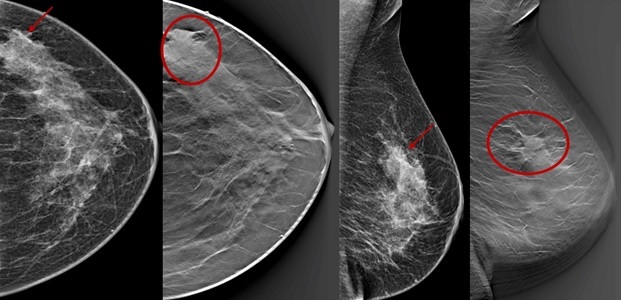It seems like a new article makes the rounds every week complaining about medical costs. A recent example published in USA Today blasted the use of screening tomosynthesis, a newer technology that involves the use of a three-dimensional mammogram. The point of the article seems to be that money-hungry companies and doctors are pushing this technology to rake in the cash. Nobody mentions the fact that it takes us radiologists three times as long to read a tomo compared with a traditional 2D mammogram, so we actually make less money. Nobody argues that tomosynthesis detects more cancers (which is kind of the point of a mammogram, right?). It is also universally accepted that tomosynthesis results in fewer false-positives, which means callbacks for additional images in a patient who ends up to not have cancer. So, to me, this is a win-win. We find more cancer, with fewer unnecessary mammograms.

The article makes the point that with tomosynthesis, we only find one additional cancer per 1000 screening mammograms. What the mathematically illiterate journalist fails to understand is that this is a huge improvement. With traditional screening mammograms, we only find 2-10 cancers per 1000 exams (average 5). So, one more than five is a 20% improvement. That’s massive! That means thousands of additional lives saved per year. How can anyone say that isn’t significant? What if your mother was one of the extra lives saved?
So, once we agree that this new technology is amazing and helpful, the sticking point seems to be money. The opponents are outraged that new machines have to be paid for. Well, I have news for you, every product costs money. Every pound of steel, every mile a product is transported, every dollar spent getting government approval. All these things cost money, and that cost has to be passed on to the final consumer. This socialist fantasy that all products and services should be free, or at least paid for by Jeff Bezos, is insane.

This weird sense of entitlement pervades medicine. I think this comes from health insurance. People feel like this is a program that is supposed to pay for all medical care. As anyone who has dealt with insurance knows, this is far from true. An insurance company has a weird business model. Their mission is to take in as much money in the form of premiums as possible, and to pay out as little as possible for our health care costs. Seems kind of crappy. But insurance/health care cost reform is a huge topic for another day.
HOSPITAL MARKUPS
Since I was a kid, I heard people rant about the “Advil that cost $25 in the hospital.” This was bandied about as proof that the hospitals were gouging us. After 16 years dealing with healthcare I can explain this phenomenon.
When you are in a hospital, you are not in a hotel. You can’t sneak in your own drinks and food and Advil. You are there because you couldn’t manage your health yourself. Whether you were in a car accident or you have cancer or perforated diverticulitis, you are sick, and you need help. When you are admitted to a hospital, you are handing over control to the professionals. When you have a headache, you tell the nurse. He tells the doctor, who spends time and expertise making sure the Advil isn’t going to cause you to bleed to death, or cause a medication interaction, or obscure some other serious issue. This highly-trained doctor approves the Advil, and spends fifteen minutes writing orders in the ten-million-dollar electronic medical record program mandated by the government. Then, the order zips to a highly-trained pharmacist, who double-checks allergies and interactions. The nurse retrieves the Advil from the insanely expensive Pyxis dispensing machine, or the pharmacist shoots the five-cent pill through the ancient tube transport system that always breaks, and your highly-trained nurse hands you the pill with a cup of water. That’s how it works. You want to pay five cents for an Advil? Stay at home.

All this coordinated work and equipment and software costs money. That’s why an Advil costs $25 in the hospital. Not because some doctors and hospital administrators are rolling in a pool of Scrooge McDuck money. Well, there’s also the issue that the previous 20 patients didn’t pay for their Advil. Either they didn’t have insurance, or the insurance company hid behind a wall of legal maneuvering to avoid paying for the Advil, and the patient couldn’t afford the bill. So, because you have good insurance and a job, you end up footing the bill for lots of other people.
In essence, we sort of do have socialized medicine. When a hospital has an emergency room, where everyone must be treated, regardless of ability to pay, there are enormous expenses. Doctors and nurses and medicines and equipment. I’m not saying it’s right or wrong, I’m just saying it’s expensive. And the money has to come from somewhere. If the hospital had to eat the costs, they would have to close their doors overnight. So, to adapt, they charge you $2000 just to walk in the door.
TRUST
At the end of the day, a lot of this comes down to trust. You should trust your doctor, and your nurse, and your hospital. If you don’t trust them, you shouldn’t go to them for care. Same with a plumber or an auto mechanic. If you think they are trying to cheat you, you should go to someone else. Or you can become a modern-day renaissance man, learn to do everything yourself. Fix you own car, unplug your sink, replace your own knee, read your own MRI. At least that way, you would only pay five cents for the Advil you need for all the headaches.
Not to mention the enormous costs to become a doctor in the first place
Spot on with the insurance. They want all our money without helping us when we need it.